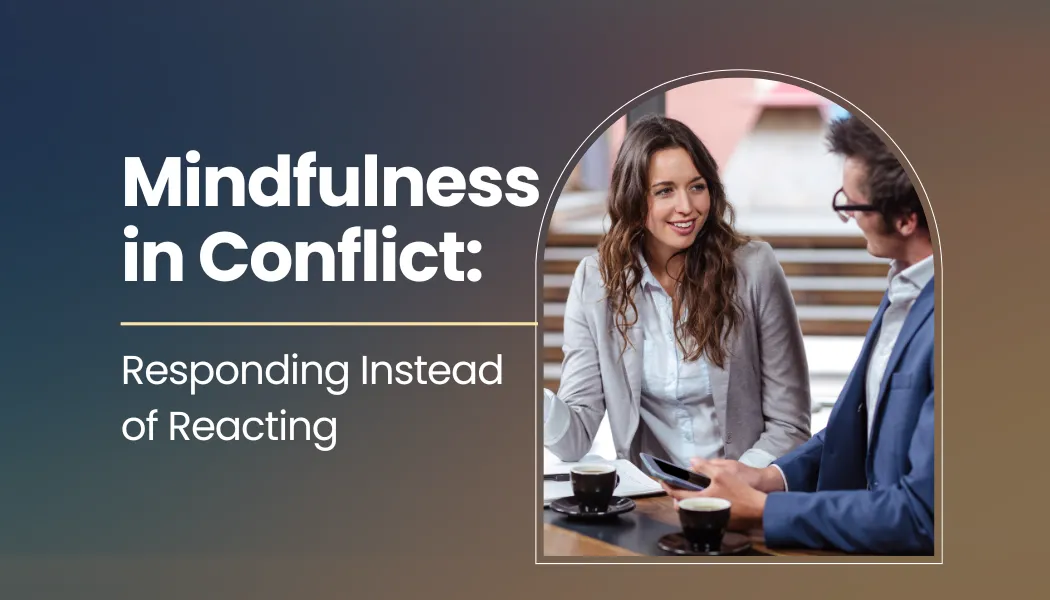Conflict is part of the human experience. From disagreements with a partner to heated debates at work, from sibling rivalries to community disputes, conflict arises whenever perspectives, needs, or values clash. For many of us, the natural tendency is to react instantly when triggered—raising our voice, shutting down, or becoming defensive. While these reactive behaviors are human, they often escalate tension instead of resolving it.
What if, instead of reacting impulsively, we could pause, ground ourselves, and respond with clarity, compassion, and intention? This is where mindfulness becomes a powerful tool. Mindfulness teaches us to notice our thoughts, emotions, and bodily sensations in real time, creating a space between trigger and response. In that space lies our ability to choose a different path—a path that transforms conflict into an opportunity for understanding, connection, and growth.
This article explores how mindfulness can shift our relationship with conflict, why reacting often makes situations worse, and practical strategies to cultivate mindful responding in everyday life.
Table of contents
- Understanding the Difference: Reacting vs. Responding
- Why Do We React in Conflict?
- The Role of Mindfulness in Conflict
- Practical Mindfulness Strategies for Conflict
- Examples of Mindful Responding in Everyday Conflicts
- The Long-Term Benefits of Mindfulness in Conflict
- Challenges in Practicing Mindfulness During Conflict
- Building a Mindful Foundation Outside of Conflict
- From Conflict to Connection: The Transformative Potential
- Final Thoughts
Understanding the Difference: Reacting vs. Responding
The terms reacting and responding might sound similar, but they carry very different implications, especially in conflict.
- Reacting is immediate, automatic, and often fueled by strong emotion. It bypasses thoughtful reflection. Imagine someone cutting you off in traffic—you might honk, curse, or tailgate without thinking. That’s a reaction.
- Responding involves a pause, awareness, and choice. Instead of following the first impulse, you consider the situation and act intentionally. In the same traffic example, a response might be taking a deep breath, slowing down, and reminding yourself that their behavior doesn’t have to ruin your day.
When conflicts arise in relationships, workplaces, or communities, reactions often ignite a cycle of defensiveness, blame, and escalation. Responses, on the other hand, invite dialogue, empathy, and resolution.
Why Do We React in Conflict?
Understanding why reactions happen helps us soften our judgment toward ourselves and others. Reactions are not signs of weakness—they are deeply wired survival mechanisms.
- The Fight-or-Flight Response
Our nervous system is designed to protect us from perceived threats. When someone yells, criticizes, or dismisses us, our body often interprets it as danger. Stress hormones flood in, our heart races, and we prepare to fight, flee, or freeze. - Conditioned Patterns
Many of us grow up learning certain conflict styles from family or culture—whether it’s shouting to be heard, withdrawing to avoid confrontation, or trying to please everyone. These patterns can become automatic reactions. - Ego and Identity
Conflict often threatens our sense of self. When criticized, we feel attacked. When ignored, we feel devalued. These perceived threats to ego trigger defensive reactions. - Unprocessed Emotions
When emotions like anger, sadness, or insecurity build up without acknowledgment, they tend to explode in reactive ways during conflict.
The good news? While we can’t always control the first impulse, mindfulness helps us recognize it without acting on it. This recognition opens the door to a different choice.
The Role of Mindfulness in Conflict
Mindfulness is the practice of paying attention to the present moment with openness, curiosity, and compassion. When applied to conflict, mindfulness becomes a tool for self-awareness, emotional regulation, and clearer communication.

Here’s how mindfulness helps:
- Creates a Pause
Mindfulness slows us down. By observing our breath, body sensations, or thoughts, we interrupt the automatic reaction and create space for a wiser response. - Regulates Emotions
Instead of being swept away by anger, frustration, or fear, mindfulness helps us notice emotions as passing states. We can feel anger without letting it control our words or actions. - Increases Empathy
By becoming more aware of our own inner experience, we also develop greater sensitivity to what others may be feeling. This empathy allows us to respond with compassion rather than aggression. - Clarifies Intention
Mindfulness invites us to ask: What outcome do I really want in this conflict? Do I want to “win,” or do I want understanding, resolution, and connection?
Practical Mindfulness Strategies for Conflict
Mindfulness is not about eliminating conflict—it’s about navigating it more skillfully. Here are practical strategies to help you respond instead of react.
1. Breathe Before You Speak
The simplest practice is often the most powerful. When you feel triggered, take one slow, deep breath before responding. This small pause disrupts the reaction cycle.
2. Notice Body Sensations
Anger and fear often show up physically—tight jaw, clenched fists, racing heartbeat. Instead of ignoring these cues, notice them. Labeling sensations (“I feel heat in my chest”) creates distance from the emotion.
3. Use the STOP Technique
- S: Stop what you’re doing.
- T: Take a breath.
- O: Observe your thoughts, feelings, and surroundings.
- P: Proceed with awareness and intention.
This quick practice can transform heated moments.
4. Practice Mindful Listening
Instead of preparing your rebuttal while the other person speaks, truly listen. Notice their words, tone, and emotions. Reflect back what you hear. Often, people de-escalate when they feel heard.
5. Shift Perspective
Ask yourself: What might this person be experiencing right now? Considering another viewpoint fosters empathy and reduces defensiveness.
6. Ground in the Present
Conflict often spirals when we bring in past grievances or future fears. Mindfulness anchors us in the present moment, focusing on the issue at hand rather than decades of resentment.
7. Practice Loving-Kindness
Silently send thoughts of well-being to yourself and the other person: May we be safe. May we be understood. May we find peace. This doesn’t excuse harmful behavior but helps soften hostility.
Examples of Mindful Responding in Everyday Conflicts
At Work
- Scenario: A colleague criticizes your idea in a meeting.
- Reaction: You snap back defensively or withdraw in silence.
- Response: You pause, take a breath, and say, “I hear your concerns. Can you explain what part feels unclear to you?”
In Relationships
- Scenario: Your partner forgets something important.
- Reaction: You accuse them of not caring.
- Response: You notice your hurt, breathe, and express: “I felt disappointed when this was forgotten because it mattered to me.”
With Family
- Scenario: A sibling makes a sarcastic comment during dinner.
- Reaction: You fire back with your own cutting remark.
- Response: You observe the urge to retaliate, let it pass, and calmly say, “That comment stung. Can we talk about it differently?”
In Community or Social Media
- Scenario: Someone posts an offensive opinion online.
- Reaction: You type an angry reply.
- Response: You pause, reflect on whether engagement is constructive, and either respond respectfully or disengage entirely.
The Long-Term Benefits of Mindfulness in Conflict
When practiced consistently, mindful responding leads to profound benefits:

- Healthier Relationships: Conflicts become opportunities for growth instead of cycles of resentment.
- Reduced Stress: Less reactivity means fewer adrenaline spikes and emotional hangovers.
- Greater Self-Mastery: You become less controlled by impulses and more aligned with your values.
- Enhanced Communication: Listening and empathy improve, creating space for authentic dialogue.
- Personal Growth: Each mindful response strengthens patience, compassion, and resilience.
Challenges in Practicing Mindfulness During Conflict
It’s important to acknowledge that mindful responding is not always easy. Some challenges include:
- Strong Emotions: Intense anger or fear can overwhelm mindfulness skills.
- Deep-Rooted Patterns: Years of reactive habits don’t disappear overnight.
- High-Stakes Conflicts: When outcomes feel critical, our nervous system may override mindfulness.
- Resistance from Others: Not everyone will respond calmly, even if you do.
The key is consistency. Each small success—each moment you pause instead of snapping—strengthens your capacity. Over time, responding mindfully becomes more natural.
Building a Mindful Foundation Outside of Conflict
To respond mindfully in the heat of conflict, it helps to build a foundation of mindfulness in daily life. Just as athletes train before the big game, we can practice mindfulness regularly so that it’s accessible when we need it most.
Daily Practices:
- Meditation: Even 5–10 minutes a day of focusing on the breath strengthens awareness.
- Mindful Walking: Notice each step, your surroundings, and your breath.
- Gratitude Journaling: Regular reflection softens the heart and increases perspective.
- Body Scans: Cultivate awareness of physical sensations, which are often the first signs of emotional reactivity.
From Conflict to Connection: The Transformative Potential
When we choose response over reaction, conflict transforms. Instead of being battlegrounds, conflicts can become bridges—moments where we learn about ourselves and others, where empathy replaces ego, and where relationships deepen.
Consider this: Most lasting growth in relationships doesn’t come from harmony but from how conflicts are navigated. Mindfulness doesn’t eliminate disagreements; it teaches us to handle them with grace, integrity, and compassion.
As Victor Frankl famously said:
“Between stimulus and response there is a space. In that space is our power to choose our response. In our response lies our growth and our freedom.”
Mindfulness helps us find that space—and within it, the freedom to transform conflict into connection.
Final Thoughts
Conflict is inevitable, but suffering through destructive cycles of reaction is not. With mindfulness, we learn to pause, breathe, and observe before we act. We shift from reacting impulsively to responding wisely.
This shift doesn’t just resolve disagreements—it protects relationships, reduces stress, and cultivates compassion. Whether at home, at work, or in our communities, choosing mindful responses over automatic reactions is one of the most powerful ways we can contribute to peace, both within ourselves and in the world around us.
By practicing mindfulness, conflict no longer needs to be a battlefield. It can become a classroom, a mirror, and a bridge to deeper understanding.
